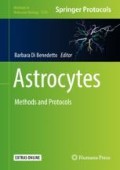Abstract
The recently discovered glymphatic system, which supports brain-wide clearance of metabolic waste, has become the subject of intense research within the past few years. Its nomenclature arose due to its functionally analogous nature to the lymphatic system in combination with glial cells that are part of its anatomical boundaries. The influx of cerebrospinal fluid (CSF) from perivascular spaces into the brain interstitium acts to clear intraparenchymal solutes. CSF is produced by the choroid plexus and flows from the ventricles to the subarachnoid space via the cisterna magna, and as such the injection of tracer molecules into any one of these spaces could be used for studying CSF movement through the glymphatic system. Of these options, the cisterna magna is most favorable as it offers a route of entry that does not involve craniotomy. Herein we describe the cisterna magna (CM) injection procedure carried out in rats, essential for studying glymphatic influx and efflux dynamics.
Access this chapter
Tax calculation will be finalised at checkout
Purchases are for personal use only
References
Liao S, Padera TP (2013) Lymphatic function and immune regulation in health and disease. Lymphat Res Biol 11:136–143
Cumming P, Ase A, Diksic M et al (1995) Metabolism and blood-brain clearance of l-3,4-dihydroxy-[3H]phenylalanine ([3H]DOPA) and 6-[18F]fluoro-l-DOPA in the rat. Biochem Pharmacol 50:943–946
Shram N, Netchiporouk L, Cespuglio R (2002) Lactate in the brain of the freely moving rat: Voltammetric monitoring of the changes related to the sleep-wake states. Eur J Neurosci 16:461–466
Nedergaard M (2013) Garbage truck of the brain. Science 340:1529–1530
Jessen NA, Munk ASF, Lundgaard I, Nedergaard M (2015) The glymphatic system: a beginner’s guide. Neurochem Res 40:2583–2599
Boespflug EL, Iliff JJ (2018) The emerging relationship between interstitial fluid–cerebrospinal fluid exchange, amyloid-β, and sleep. Biol Psychiatry 83:328–336
Mestre H, Kress BT, Zou W et al (2017) Aquaporin-4 dependent glymphatic solute transport in rodent brain. bioRxiv 216499
Kress BT, Iliff JJ, Xia M et al (2014) Impairment of paravascular clearance pathways in the aging brain. Ann Neurol 76:845–861
Lundgaard I, Lu ML, Yang E et al (2017) Glymphatic clearance controls state-dependent changes in brain lactate concentration. J Cereb Blood Flow Metab 37:2112–2124
Iliff JJ, Wang M, Liao Y et al (2012) A paravascular pathway facilitates CSF flow through the brain parenchyma and the clearance of interstitial solutes, including amyloid β. Sci Transl Med 4:147ra111
Nagelhus EA, Ottersen OP (2013) Physiological roles of Aquaporin-4 in brain. Physiol Rev 93:1543–1562
Solenov E (2004) Sevenfold-reduced osmotic water permeability in primary astrocyte cultures from AQP-4-deficient mice, measured by a fluorescence quenching method. Am J Physiol Cell Physiol 286:426C–4432C
Huber VJ, Igarashi H, Ueki S et al (2018) Aquaporin-4 facilitator TGN-073 promotes interstitial fluid circulation within the blood–brain barrier. Neuroreport 29:697–703
Xavier ALR, Hauglund NL, von Holstein-Rathlou S et al (2018) Cannula implantation into the cisterna magna of rodents. J Vis Exp 135:e57378
Yang L, Kress BT, Weber HJ et al (2013) Evaluating glymphatic pathway function utilizing clinically relevant intrathecal infusion of CSF tracer. J Transl Med 11:107
Xie L, Xie L, Kang H et al (2013) From the adult. Brain 373:373–378
Groothuis DR, Vavra MW, Schlageter KE et al (2007) Efflux of drugs and solutes from brain: the interactive roles of diffusional transcapillary transport, bulk flow and capillary transporters. J Cereb Blood Flow Metab 27:43–56
Benveniste H, Lee H, Ding F et al (2017) Anesthesia with dexmedetomidine and low-dose isoflurane increases solute transport via the glymphatic pathway in rat brain when compared with high-dose isoflurane. Anesthesiology 127:976–988
Acknowledgements
The Knut and Alice Wallenberg Foundation is acknowledged for generous support.
Author information
Authors and Affiliations
Corresponding author
Editor information
Editors and Affiliations
Rights and permissions
Copyright information
© 2019 Springer Science+Business Media, LLC, part of Springer Nature
About this protocol
Cite this protocol
Ramos, M. et al. (2019). Cisterna Magna Injection in Rats to Study Glymphatic Function. In: Di Benedetto, B. (eds) Astrocytes. Methods in Molecular Biology, vol 1938. Humana Press, New York, NY. https://doi.org/10.1007/978-1-4939-9068-9_7
Download citation
DOI: https://doi.org/10.1007/978-1-4939-9068-9_7
Published:
Publisher Name: Humana Press, New York, NY
Print ISBN: 978-1-4939-9067-2
Online ISBN: 978-1-4939-9068-9
eBook Packages: Springer Protocols

